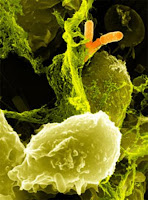The group of scientists lead by Arturo Zychlinsky at the Max-Planck-Institute for Infectious Biology discovered a second killing mechanism: neutrophil granulocytes can form web-like structures outside the cells composed of nucleic acid and enzymes which catch bacteria and kill them. The scientists were able to generate impressive micrographs of these nets. But it remained a mystery how the granulocytes could mobilise the contents of their nuclei and catapult it out of the cells.
Only after lengthy live cell imaging and biochemical studies it became clear how neutrophils make NETs. The cells get activated by bacteria and modify the structure of their nuclei and granules, small enzyme deposits in the cytoplasm. "The nuclear membrane disintegrates, the granules dissolve, and thus the NET components can mingle inside the cells", explains Volker Brinkmann, head of the microscopy group. At the end of this process, the cell contracts until the cell membrane bursts open and quickly releases the highly active melange. Once outside the cell, it unfolds and forms the NETs which then can trap bacteria.
Surprisingly, this process is as effective as devouring bacteria: "NETs formed by dying granulocytes kill as many bacteria as are eaten up by living blood cells", says Arturo Zychlinsky. Thus, neutrophils fulfil their role in the defence battle even after their deaths. ###
Original work: Tobias A. Fuchs, Ulrike Abed, Christian Goosmann, Robert Hurwitz, Ilka Schulze, Volker Wahn, Yvette Weinrauch, Volker Brinkmann and Arturo Zychlinsky
Novel Cell Death Program Leads to Neutrophil Extracellular Traps, Journal of Cell Biology, online published, January 8, 2007
Contact: Prof. Dr. Arturo Zychlinsky Zychlinsky@mpiib-berlin.mpg.de 49-302-846-0300 Max-Planck-Gesellschaft
Technorati Tags: white blood cells and neutrophil granulocytes or Neutrophil Extracellular Traps and bactericidal enzymes or bone marrow and immune system or bacteria and Infection Biology or antimicrobial proteins and PODCAST












No comments:
Post a Comment